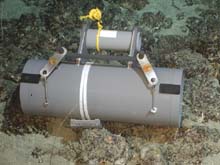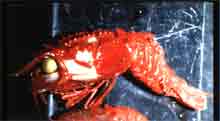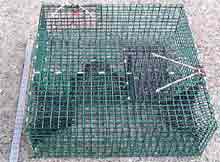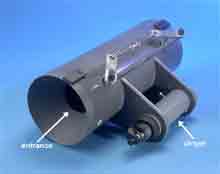
Figure 1: The new benthic trap on the bottom, ready to collect animals that won’t be blinded by the light. Click image for larger view.
Capturing Benthic Animals: New Trap Keeps Them Cold and In the Dark
Tammy FrankAssociate Scientist
Harbor Branch Oceanographic Institution
The visual systems of deep benthic (bottom-dwelling) shrimp have never been studied. The reason: the collection process rendered the specimens blind. The shrimp live in a dim light environment. Based on the relatively large size of their eyes (Figure 1), these animals are clearly adapted for extremely sensitive vision. When we bring them up from the deep in a standard shrimp trap (Figure 2), the light at the surface permanently blinds them. Even at night, exposure to the bright ship lights will cause permanent damage to their eyes.
Scientists on Operation Deep Scope won't have this problem. We will use light-tight, insulated, shrimp/crab traps, which can be deployed and retrieved with the Johnson-Sea-Link submersible. The Harbor Branch Oceanographic Institution's engineering department designed and built these traps, and we're looking forward to the results.

Figure 2: A benthic shrimp (Glyphocrangon) that lives at 700-1500 m depth. Click image for larger view.
Benthic Trap Innovations
The new traps are made out of PVC pipe, with two doors held open by magnesium links. These magnesium links dissolve in seawater, and once they’ve dissolved, the doors of the trap snap shut, leaving a light-tight container. With any luck, small crabs and shrimps will fill the trap, attracted to the bait inside. A pinger, attached to each trap, allows the Johnson-Sea-Link pilots to detect and retrieve them. The Johnson-Sea-Link can pick up the closed traps, without exposing the captured animals to the submersible's bright lights.
The traps feature another important design element: thick walls that insulate the water inside and keep it very cold. Most people think that rapid pressure changes kill deep-sea animals brought to the surface, but this is true only for animals with air-filled spaces (such as fish that have swim bladders). Shrimp and crabs don’t have any air-filled spaces, and for those species living above 1000 m, pressure changes don’t cause any significant problems for them. Temperature changes, however, can be lethal.
Keeping Samples Chilled
Deep benthic shrimp live at depths, where the temperature is normally around 4° C (40° F). Comparatively, the temperature in the surface waters runs between 24-29° C (75-85° F). This dramatic change in temperature is deadly to these deep-sea species. While they may be alive when an uninsulated trap gets to the surface, they won’t live very long. Animals that are kept in cold water on the way to the surface and in the lab, however, will live for several weeks.
Once the traps are back on board the research vessel, scientists will open them in a 4° C light-tight cold room under dim red light. They will remove the animals inside and put them into light-tight seawater tanks for later experiments.

























